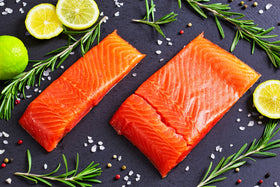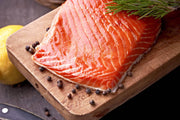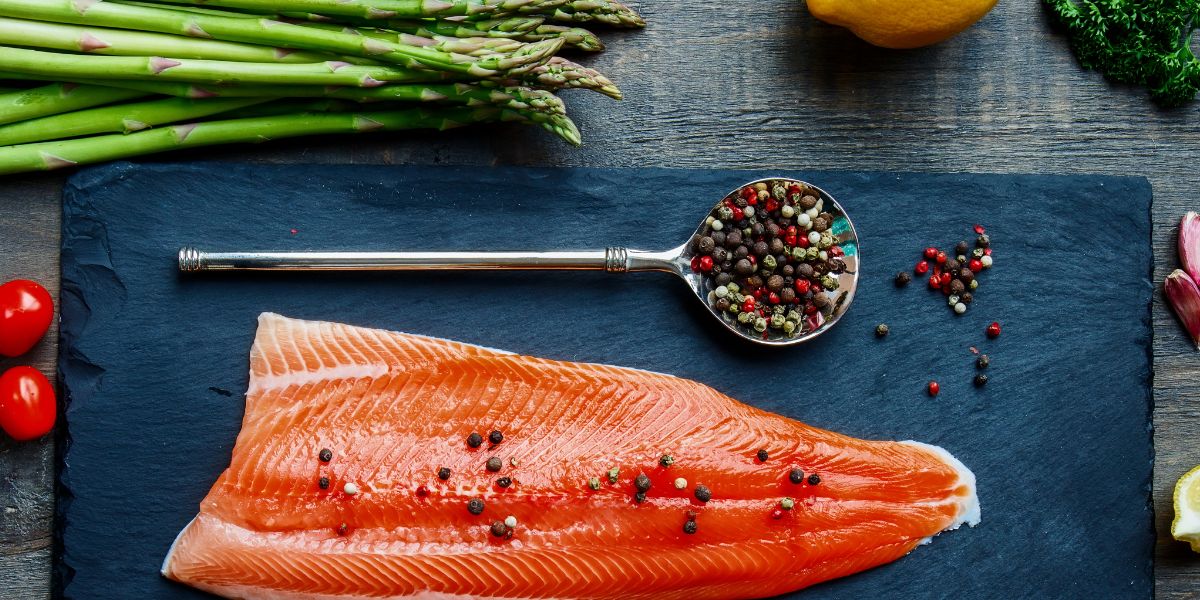Some of the many benefits wild caught salmon include:
- No added chemicals
- No artificial coloring
- No preservatives
- No pesticides
- No growth hormones
- No antibiotics
- No GMOs
Why Wild Fish Oil Omega 3s Are Important For Your Health:
It is well established that eating fish regularly helps protect against developing heart disease and heart attack. The oils in fish are unique; they have omega 3s–fatty acids not found in any other foods. The omega 3s in fish improve heart function and make other conditions that contribute to heart disease less dangerous. For these reasons, the American Heart Association urges everyone to consume fish at least twice a week—especially fatty species such as salmon, herring, black cod, mackerel, and sardines. For people who already have heart disease, the oils in fish may be especially important, as they may improve the condition. Here are some ways omega 3s from fish help our hearts:
- Maintain normal heart rhythms—When the rhythmic beating of the heart gets out of order, a dangerous pattern of rapid heartbeats can develop, and these can be fatal. Omega 3s from fish help maintain a healthy pattern of regular heartbeats and make it more difficult for abnormal rhythms to develop.
- Reduce the chance of sudden death— Nearly half of all cardiac deaths occur suddenly, before a person can seek help. Omega 3s from fish help to maintain stable heartbeats, making it more difficult for potentially fatal, rapid, uncontrolled rhythms to develop.
- Reduce the chance of stroke—Blood clots that develop in the brain or are carried to the brain from elsewhere cause strokes and serious disability. People who eat fish regularly are less likely to develop strokes.
- Lower chance of having a first heart attack— People at high risk of having a heart attack may be less likely to develop one if they consume the omega 3s from fish on a regular basis. Omega 3s help the heart by slowing the development of atherosclerosis (clogged blood vessels) and improving heart function.
- Reduce inflammation—As heart disease develops, blood vessels become mildly inflamed and this makes heart failure more likely. This inflammation is greatly reduced in people who regularly consume fatty fish or the omega 3s from fish.
- Improve the pattern of lipids in the blood— Different types of lipids (fat-like substances) are carried in the blood. The omega 3s found in fish can dramatically lower the amount of blood fats (triglycerides) in blood and this reduces the chance of a heart attack. People with type 2 diabetes and certain types of heart disease can have very high levels of blood triglycerides. Eating fatty fish or the omega 3s found in fish is one of the best ways of lowering the amounts of these fats.
- Improve “good” cholesterol or HDL levels— People who have higher levels of HDL or “good” cholesterol in their blood have a lower chance of heart failure. HDL helps remove cholesterol from the blood vessels where it can be harmful. Regularly eating fish or the omega 3s from them helps boost blood levels of HDL or “good” cholesterol.
- Lower blood pressure—High blood pressure or hypertension increases the chance of heart disease and stroke, but can usually be well controlled by medications. High blood pressure is sneaky because it can develop without a person knowing it. People who eat fish regularly consistently have slightly lower blood pressure than those who do not eat fish regularly. Achieving and keeping a healthy body weight is especially important for lowering blood pressure.
- Lower chance of blood clots—We need some blood clotting to heal injuries, but if blood clots too readily, it can block a blood vessel in the heart or brain. When this happens it can be fatal. The omega 3s from fish reduce the tendency to form blood clots and improve blood flow. Omega 3s also make red blood cells more flexible so that circulation through small blood vessels is improved.
- Better blood vessel function—Our arteries do more than send blood around the body. Their cells are miniature chemical factories making substances that affect blood flow and the flexibility of the artery wall. With the omega 3s from fish, arteries are more elastic and less likely to promote the formation of blood clots. As a result, blood flow and blood pressure are improved.
- Improved heart rate adaptability—A person’s pattern of heartbeats normally has small beat-to-beat changes. These small changes reflect the heart’s ability to adapt to changes in its environment. When fish oil omega 3s are present, the heart rate shows greater flexibility compared to its variability without omega 3s. Having greater variability in heart rate is linked to lower heart disease and less likelihood of dying from heart disease.
- More stable arterial plaques—One of the riskiest aspects of heart disease is the build-up of deposits or plaques in the blood vessels close to and in the heart. These plaques begin in childhood and indicate atherosclerosis. As the plaques grow larger they are more likely to break apart, starting a chain of events that can lead to heart failure. There is growing evidence that the omega 3s from fish help make these plaques more stable and less likely to rupture.
Kwee-Jack's Salmon Oil Supplement Can Help!
It is not always easy to get enough Omega 3s through food sources, and some people are not fans of salmon. With this in mind, we have created a wild Alaskan salmon oil supplement to help you in your quest to increase your Omega 3 intake.
Or, if you prefer to shop on Amazon, you can find our salmon oil there.
Health Benefits of Wild Alaskan Salmon
Heart Health
Omega 3s inhibit the formation of blood clots. This is important because most heart attacks result when blood clots get stuck together in the blood vessels leading to the heart. They may protect against sudden cardiac arrest, a major cause of death from heart disease. They lower very high levels of triglycerides, a type of fat in the blood which, when elevated, increases the risk of heart attacks.
Intake of fish rich in omega 3 fat (including salmon) is associated with decreased risk of numerous cardiovascular problems, including: heart attack, stroke, heart arrhythmia, high blood pressure, and high triglycerides in the blood. Intake of omega 3-containing fish is also associated with improved metabolic markers for cardiovascular disease.
Brain Health
Many researchers consider DHA to be the most important fat found in the human brain, and the unusual concentration of this omega 3 fatty acid in salmon helps explain the research-documented benefits of salmon and omega 3 fish intake for thinking and the decreased risk of certain brain-related problems that accompanies omega 3 fish consumption. There is also evidence of decreased risk of cognitive decline in the elderly with regular omega 3 consumption.
Joint Health
Research on fish intake and joint protection has shown that EPA from fish like salmon can be converted by the body into three types of closely-related compounds that work to prevent unwanted inflammation.
Eye Health
Omega 3 intake and consumption of omega 3 fish has been associated with decreased risk of two eye-related problems: macular degeneration and chronic dry eye. Improvement has been noted with 2-6 weekly servings of salmon.
Cancer-Fighting Benefits
Intake of fish rich in omega 3 fat is also associated with decreased risk for several types of cancer. These cancer types include colorectal cancer, prostate cancer, and breast cancer. Some of the strongest findings for decreased cancer risk following regular intake of omega 3 fish involve the blood cell or lymph cell-related cancers including leukemia, multiple myeloma, and non-Hodgkins lymphoma. Similar to cardiovascular studies, cancer risk studies typically begin to show measurable benefits when omega 3 fish are consumed at least once per week.
Omega 3 Consumption
In the average U.S. diet, the ratio of omega 3 to omega 6 has repeatedly been shown to be lop-sided in the opposite direction, with at least 4-5 times as much omega 6 fat as omega 3 fat, and in some studies, up to 12-20 times more. Omega 6’s have pro-inflammatory properties, which can be beneficial in some cases; however, with too many omega 6’s and not enough omega 3s comes the risk for many diseases. Increasing omega 3 consumption leads to improved control of the body’s inflammatory processes, better overall cell function, improved transfer of information between the body’s cells, and better brain function.
Sockeye salmon has the highest amount of omega 3 of any fish with approximately 2.7 grams per 100-gram portion. Therefore, just one serving of Alaska Salmon per week can help to lower cholesterol and the risk of heart disease.
In research from a team of scientists at the Lipid and Diabetes Research Center at Saint Luke’s MidAmerica Heart Institute in Kansas City, MO, only two servings of salmon per week were determined to significantly increase the presence of omega-3 fats in the membranes of red blood cells (RBCs).
“To achieve these wonderful benefits, all we have to do is have two Wild Salmon meals per week. I clearly tell people to eat wild-caught fish regularly to lower the risk of heart disease. There is compelling evidence to say that seafood-eating will benefit your health.”
Penny Kris-Ethert, Ph.D., Heart Disease Researcher, Pennsylvania State University.




Want Direct Access to Wild Caught Seafood?
From our fishermen to your front door. We ship our wild caught seafood to all U.S. lower 48 states, and offer many pickup locations across the U.S.
Wild Caught Alaskan Sockeye Salmon Nutrition Details
Nutrient % Daily Value for 4oz (113.4g) Wild Sockeye Salmon
- Vitamin D 127.8%
- Vitamin B12 94.5%
- Tryptophan9 3.7%
- Selenium 61.5%
- Protein 53.1%
- Omega 3’s 52.5%
- Vitamin B3 45.1%
- Phosphorus 36.5%
- Vitamin B6 32%
- Choline 19.2%
- Potassium 14%
- calories (157) 8%
Wild Caught Alaskan Salmon also provides important amounts of:
- the antioxidant amino acid taurine
- heart-healthy vitamin B12
- anti-inflammatory omega-3 fatty acids
- immune-supportive selenium
- energy-producing phosphorus
- muscle-building protein
- heart-healthy niacin, vitamin B12, vitamin B6, and potassium
- bone-building vitamin D*
*Salmon contains more than 100IU of vitamin D per ounce. Vitamin D has been shown to be a critical factor in preventing unwanted inflammation, in supporting cognitive function, and in lowering risk of several types of cancer, including breast, prostate, and colorectal cancer.
How else is wild salmon healthy for me?
The Immune System
The immune system protects the body from foreign invaders such as bacteria, viruses and allergens by producing specific antibodies for each invader. Once an antibody latches on to the intruder, it becomes marked for destruction and removal by other immune cells. Another part of the immune system removes infected cells and generates inflammation—the swelling, pain, heat, redness and sometimes itching—that develops around an insect bite, wound, or the body’s own tissue (e.g., rheumatoid arthritis).
Inflammatory responses promote healing and limit tissue damage from an injury or harmful agent. Excessive immune responses pave the way to several chronic diseases, such as diabetes, cardiovascular disease, rheumatoid arthritis, and multiple sclerosis. They underlie allergies or hypersensitivity to foreign irritants (antigens) like pollen or certain food proteins. Common allergies produce inflammatory responses in skin, nose and eyes. In chronic diseases, inflammation is responsible for the joint pain of rheumatoid arthritis, the breathing difficulties of asthma, and the itchy red skin of psoriasis and eczema.
Polyunsaturated fatty acids greatly affect inflammatory responses because of substances made from them. Products from arachidonic acid, derived from vegetable oils, usually increase inflammatory responses. In contrast, the omega 3 fatty acids from fish and shellfish, EPA∗ and DHA,∗ help restrain runaway inflammation.
EPA reduces the amount of inflammatory products made from arachidonic acid and is converted to compounds that are weakly anti-inflammatory. Other newly discovered substances made from seafood omega 3s have potent effects in ending inflammatory responses. Allergic diseases are increasing in western countries. Some experts have suggested that declining consumption of omega 3s and antioxidants (e.g., vitamins E and C), along with the high intake of omega 6 fatty acids from vegetable oils favor the development of allergies such as eczema, asthma and hay fever. Eating less fat of all kinds and more seafood omega 3s has been associated with improved immune function and less severe symptoms in some people with these allergic conditions.
Rheumatoid Arthritis
In rheumatoid arthritis the body’s immune system targets the joints causing pain, stiffness, swelling and deformity. It is three times more common in women than men. Fish oil has been used to treat rheumatoid arthritis for many years and has helped ease the symptoms of morning stiffness, pain, and swollen joints. Fish oil also reduces the production of inflammatory substances and reduces the activity of enzymes that erode joint tissue.
However, it can take from 6 to 12 weeks before improvements are noticed. It also requires fairly hefty doses, in the range of 4 grams of omega 3s (EPA and DHA) or more per day. This is more than can be obtained from foods alone and may require the consumption of 10 or more capsules daily, depending on the concentration of EPA and DHA. Alternatively, one can take liquid fish oil, which is usually more concentrated than capsules.
In addition to improving symptoms, adding fish oil to other arthritis medications may reduce the amount of non-steroidal anti-inflammatory drugs needed for pain control. Seafood omega 3s have many protective effects on heart health, an important benefit as people with rheumatoid arthritis are at greater risk of heart disease. Further, seafood omega 3s are without harmful side effects. Before taking large amounts of fish oil, people should consult with their doctor, especially if they are taking blood-thinning medications.
Asthma
Asthma results from chronic inflammation of the airways. The condition affects about 16 million American adults, but often begins in childhood. People with asthma have episodes of breathing difficulty, wheezing, breathlessness, chest tightness and coughing. Breathing problems can be triggered by allergens, irritating substances in the air (e.g., smoke), infection and exercise. Although there are many studies of the effects of fish oil in people with asthma, findings are mixed and inconclusive.
Many studies found little benefit from moderately high amounts of omega 3s. However, several epidemiological studies (observations comparing the condition in one group with another) indicate that low omega 3 intake and levels in blood are linked to greater occurrence of asthma. In addition, foods consumed in most western countries, particularly in the U.S., are high in the fatty acids that promote inflammatory responses (polyunsaturated vegetable oils) and very low in omega 3s. Several studies with fish oil supplementation reported that inflammatory substances were significantly reduced, even if symptoms were unaffected.
More recent research in asthmatic patients undergoing exercise reported that the consumption of fish oil for 3 weeks prior to exercise significantly improved lung function, reduced the use of a bronchodilator (inhaler), and decreased the production of inflammatory substances.
Several studies in children at risk of asthma suggest that consuming fish in early childhood, before the age of one year, may reduce the chance of developing the condition, delay it, or result in less severe symptoms. Children with higher intakes of seafood omega 3s have less wheezing and coughing compared with children with low levels. Omega 3s do not prevent the condition, but help make it less severe.
Eczema
Another allergic inflammatory condition is eczema, a chronic skin disease, often linked to family history. Some forms of eczema, usually in patients with a family history of eczema, have altered polyunsaturated fatty acid metabolism that results in lower production of anti-inflammatory substances. In several studies, fish consumption or supplementation with EPA and DHA resulted in less severe symptoms in people with the condition. Fish oils reduced the production of inflammatory substances and increased the production of those with anti-inflammatory effects. There are also reports of less severe allergies in infants and children whose mothers consumed fish oil during pregnancy. It is not clear whether the benefits observed in infancy persist into later childhood. Early exposure to omega 3s, as in pregnancy, may be advantageous, but more studies are needed to confirm this possibility.
Much remains to be learned about these complex immune conditions before saying for certain that fish oils prevent eczema. However, regular fish consumption or omega 3 supplementation may offer some relief to those suffering from them.
Sustainability of Wild Alaskan Sockeye Salmon
Farmed Salmon vs. Wild Caught Salmon
(read our full article on wild vs. farmed salmon)
We have all heard that eating salmon is a healthy thing to do; however a study published in Science reported that some varieties of farmed salmon contained high levels of cancer-causing chemicals called PCBs, which caused some people to shy away from farmed varieties. (More than 80% of the fresh salmon eaten in the U.S. is farmed.) The PCBs come from the fish meal and fish oil the salmon are fed. However, this is not the only problem with farmed salmon. The trend toward greatly increased salmon farming has been an ongoing concern to many researchers who study the ecological impact of farmed salmon, including the impact on wild salmon populations.
Salmon farming has also concerned many researchers from a health standpoint. Farmed salmon when raised in a non-sustainable way and without regard for the organic standards that exist in some countries outside the U.S. have repeatedly been found to have measurable and undesirable amounts of numerous contaminants. Some researchers have raised the question of whether sustainable salmon farming is even possible, given the natural habits of salmon and the unique habitats that have historically supported their vitality.
However, there are still salmon runs that pose relatively low risk in terms of contaminants. Leading this low-risk category for wild-caught salmon are Alaskan salmon. Southeast Alaskan chum, sockeye, coho, pink, and chinook salmon, together with Kodiak coho, pink, and chum salmon have all been evaluated for contaminant consumption risk involving many POPs (including dioxins, dioxin-like compounds, or DLCs, and polychlorinated biphenyls, or PCBs) and have been found to be the lowest risk category of wild-caught salmon for regular consumption. This lower contamination risk amongst all wild-caught salmon is one of the reasons why wild-caught Alaskan salmon is the recommended salmon of choice.
Along with lower risk of contamination from wild-caught Alaskan salmon, Monterey Bay Aquarium in Monterey, California has recently determined Alaskan salmon to be the only low-risk salmon in terms of four sustainability criteria: the inherent vulnerability of the fish, the effects of fishing on the overall habitat, the status of wild stocks, and the nature of the by-catch (the other types of fish that are caught unintentionally during salmon fishing).
Alaska’s human population density is among the lowest of any in the United States, and lower than most places in the world. Alaska has little heavy industry, and has strict regulations governing development activities, such as road building, mining, logging, and sewage treatment. The State of Alaska Department of Environmental Conservation (ADEC) has a regulatory section dealing specifically with water quality. Water discharges, such as sewage and other potential pollutants, are closely regulated to ensure high water quality. In addition, ADFG requires prior approval for any in-stream construction activities in Alaska’s salmon streams through the authority of the Alaska statutes known as the “Anadromous Fish Act” (Alaska Statute 16.05.870). Alaska also has a Forest Practices Act requiring buffer zones from logging along salmon streams to prevent erosion and protect spawning and rearing habitat. Clean marine habitats produce pure seafood products.
Effective, precise management assures Alaska’s fisheries are productive, sustainable, clean, and healthy-as mandated by the Alaska state government. Since admittance into the Union as the 49th state in 1959, Alaska has served as a model of fisheries management around the globe. One reason for this is that Alaska remains the lone state in the nation with a constitutional mandate stipulating all fish “be utilized, developed and maintained on the sustained yield principle.”
Based on a combination of sustainability and potential contamination concerns, it is recommended that you select wild-caught Alaskan salmon above all other forms of salmon currently available.
A few tips about seafood quality and preparation:
With recent technological advances, fishing fleets are able to clean and flash-freeze fish virtually moments after they are caught. Flash-freezing instantly freezes the water inside of the fish tissues, thus preserving juices and maximizing flavor and texture when cooked. Quality and freshness in our salmon is maintained because the fish is packed and shipped frozen and not thawed until you open the package. If you can’t get the salmon within a day or two of being caught, this is the next best alternative. You should not be able to taste the difference.
If you are preparing certified organic farmed salmon or wild-caught Alaskan salmon, you may want to leave the skin intact since it contains health supportive nutrients, including peptides with anti-inflammatory potential.
Be careful not to char or burn the salmon, as this can deplete the nutrient content and produce free radicals that can be dangerous to your health.
Written by: Angela Echo-Hawk || 2011
References:
- https://www.pritikin.com/your-health/healthy-living/eating-right/1048-the-benefits-a-risks-of-eating-salmon.html
- https://www.alaskaseafood.org/information/
- https://www.livestrong.com/article/41497-grilled-salmon-nutrition-information/tname=foodspice&dbid=104
- Fish Oil Omega 3s written by Joyce A. Nettleton, DSc, RD, ScienceVoice Consulting, Denver, CO
- The Immune System written by Joyce A. Nettleton, DSc, ScienceVoice Consulting, Denver, C
















